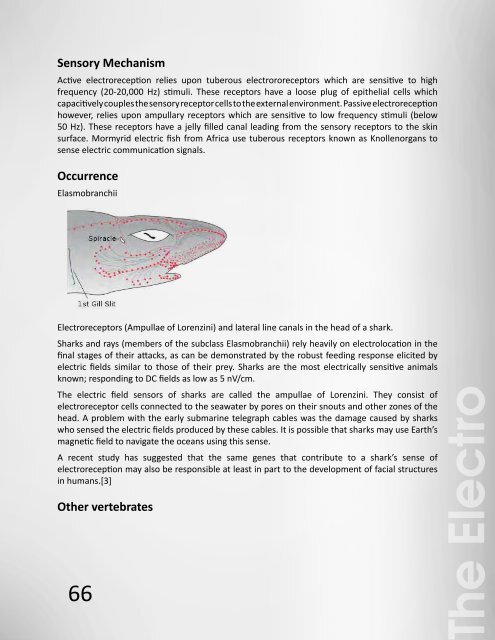The Electro Sense
The Electro Sense
The Electro Sense
- No tags were found...
Create successful ePaper yourself
Turn your PDF publications into a flip-book with our unique Google optimized e-Paper software.
Sensory MechanismActive electroreception relies upon tuberous electrororeceptors which are sensitive to highfrequency (20-20,000 Hz) stimuli. <strong>The</strong>se receptors have a loose plug of epithelial cells whichcapacitively couples the sensory receptor cells to the external environment. Passive electroreceptionhowever, relies upon ampullary receptors which are sensitive to low frequency stimuli (below50 Hz). <strong>The</strong>se receptors have a jelly filled canal leading from the sensory receptors to the skinsurface. Mormyrid electric fish from Africa use tuberous receptors known as Knollenorgans tosense electric communication signals.OccurrenceElasmobranchii<strong>Electro</strong>receptors (Ampullae of Lorenzini) and lateral line canals in the head of a shark.Sharks and rays (members of the subclass Elasmobranchii) rely heavily on electrolocation in thefinal stages of their attacks, as can be demonstrated by the robust feeding response elicited byelectric fields similar to those of their prey. Sharks are the most electrically sensitive animalsknown; responding to DC fields as low as 5 nV/cm.<strong>The</strong> electric field sensors of sharks are called the ampullae of Lorenzini. <strong>The</strong>y consist ofelectroreceptor cells connected to the seawater by pores on their snouts and other zones of thehead. A problem with the early submarine telegraph cables was the damage caused by sharkswho sensed the electric fields produced by these cables. It is possible that sharks may use Earth’smagnetic field to navigate the oceans using this sense.A recent study has suggested that the same genes that contribute to a shark’s sense ofelectroreception may also be responsible at least in part to the development of facial structuresin humans.[3]Other vertebrates<strong>The</strong> <strong>Electro</strong><strong>Sense</strong><strong>The</strong> Platypus has a powerful electro-sense<strong>The</strong> platypus also uses electroreception.<strong>The</strong> electric eel, besides its ability to generate high voltage electric shocks, uses lower voltagepulses for navigation and prey detection in its turbid habitat. This ability is shared with otherGymnotiformes.Monotremes are the most prevalent mammals that use electroception. Among these, the platypushas the most acute sense.[4][5] <strong>The</strong> platypus appears to use electroreception along with pressuresensors to determine the distance to prey from the delay between the arrival of electrical signalsand pressure changes in the water.[5]References• Szabo, T. (1980) Elektrische Fische und Elektrorezeption. Leopoldina. 22:131-151.• Hopkins, CD (May 1999). „Design features for electric communication”. J Exp Biol 202: 1217–1228.• Cohn, Martin J.; Freitas, Renata, Zhang, GuangJun, Albert, James S. & Evans, David H. (January2006). „Developmental origin of shark electrosensory organs”. Evolution & Development(Blackwell Publishing, Inc) 8: 74.• H, Scheich; Langner G, Tidemann C, Coles RB, Guppy A. (1986 January 30-February 5).„<strong>Electro</strong>reception and electrolocation in platypus”. Nature (Nature Publishing Group)319(6052): 401–2.• a b Pettigrew, John D. (1999). „<strong>Electro</strong>reception in Monotremes” (PDF). <strong>The</strong> Journal ofExperimental Biology (202): 1447–1454. http://jeb.biologists.org/cgi/reprint/202/10/1447.pdf. Retrieved on 19 September.66 67
















